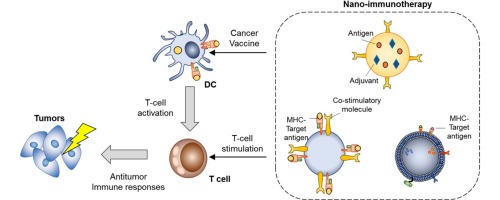当前位置:
X-MOL 学术
›
Nano Today
›
论文详情
Our official English website, www.x-mol.net, welcomes your
feedback! (Note: you will need to create a separate account there.)
Harnessing designed nanoparticles: Current strategies and future perspectives in cancer immunotherapy
Nano Today ( IF 13.2 ) Pub Date : 2017-12-01 , DOI: 10.1016/j.nantod.2017.10.008 Sung Duk Jo , Gi-Hoon Nam , Gijung Kwak , Yoosoo Yang , Ick Chan Kwon
Nano Today ( IF 13.2 ) Pub Date : 2017-12-01 , DOI: 10.1016/j.nantod.2017.10.008 Sung Duk Jo , Gi-Hoon Nam , Gijung Kwak , Yoosoo Yang , Ick Chan Kwon

|
Abstract Although cancer immunotherapy, represented by chimeric antigen receptor (CAR) T-cell therapy and immune checkpoint-blockade therapies, has shown durable outcomes, the percentage of patients that respond to these approaches remains modest to date. However, encouraging recent advances suggest that nanotechnology has the potential to enhance the efficacy of such immunotherapies by improving the delivery, biodistribution, and release-kinetics of immunostimulatory small molecules and biologics in targeted tissues. A variety of synthetic nanoparticles, including polymeric nanoparticles, liposomes and inorganic nanoparticles, can be engineered according to their intended uses in cancer immunotherapy. Notably, nature-derived nanoparticles have emerged as a new class of immunotherapeutics. In this review, we describe state-of-the-art strategies for cancer immunotherapy using designed nanoparticles. We also highlight key translational challenges and opportunities in this rapidly growing field.
中文翻译:

利用设计的纳米粒子:癌症免疫治疗的当前策略和未来前景
摘要 尽管以嵌合抗原受体 (CAR) T 细胞疗法和免疫检查点阻断疗法为代表的癌症免疫疗法已显示出持久的结果,但迄今为止,对这些方法有反应的患者比例仍然不大。然而,令人鼓舞的最新进展表明,纳米技术有可能通过改善靶向组织中免疫刺激性小分子和生物制剂的递送、生物分布和释放动力学来提高此类免疫疗法的功效。各种合成纳米粒子,包括聚合物纳米粒子、脂质体和无机纳米粒子,可以根据它们在癌症免疫治疗中的预期用途进行设计。值得注意的是,天然衍生的纳米粒子已成为一类新的免疫治疗剂。在这次审查中,我们描述了使用设计的纳米粒子进行癌症免疫治疗的最先进策略。我们还强调了这一快速发展领域的关键转化挑战和机遇。
更新日期:2017-12-01
中文翻译:

利用设计的纳米粒子:癌症免疫治疗的当前策略和未来前景
摘要 尽管以嵌合抗原受体 (CAR) T 细胞疗法和免疫检查点阻断疗法为代表的癌症免疫疗法已显示出持久的结果,但迄今为止,对这些方法有反应的患者比例仍然不大。然而,令人鼓舞的最新进展表明,纳米技术有可能通过改善靶向组织中免疫刺激性小分子和生物制剂的递送、生物分布和释放动力学来提高此类免疫疗法的功效。各种合成纳米粒子,包括聚合物纳米粒子、脂质体和无机纳米粒子,可以根据它们在癌症免疫治疗中的预期用途进行设计。值得注意的是,天然衍生的纳米粒子已成为一类新的免疫治疗剂。在这次审查中,我们描述了使用设计的纳米粒子进行癌症免疫治疗的最先进策略。我们还强调了这一快速发展领域的关键转化挑战和机遇。











































 京公网安备 11010802027423号
京公网安备 11010802027423号